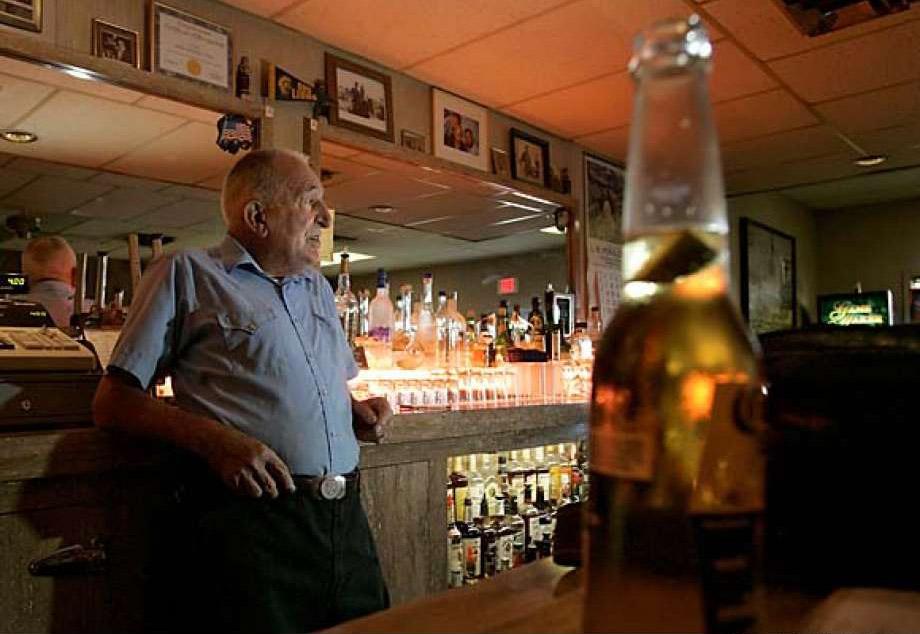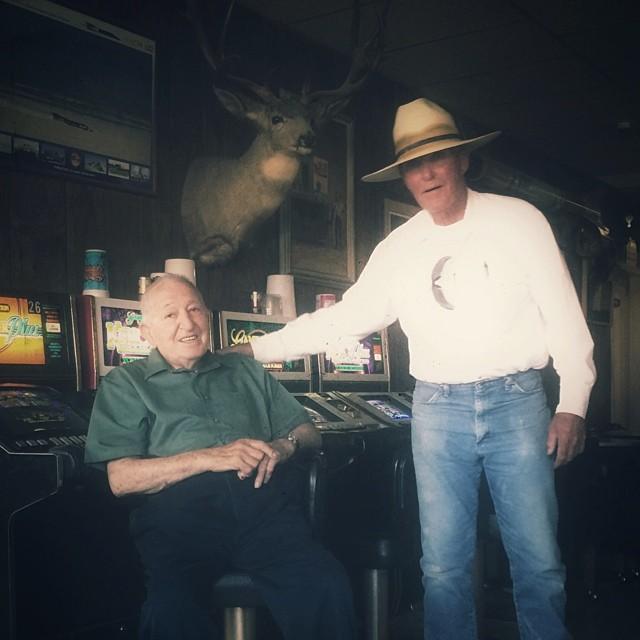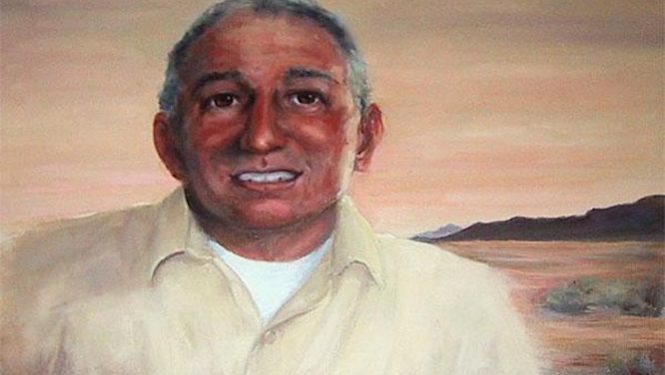Bruno’s Country Club was the most notable building in Gerlach when Burning Man first arrived there in 1990. Constructed in a style typical of frontier architecture, the front wall extends above the roof to create a more impressive façade. Over the years, we would come to know Bruno himself as an impressive character, even larger in life.
Giovanni “Bruno” Selmi arrived in the United States from Lucca, Italy, in November 1946 at the age of 23. His brother had a ranch in Dayton, Nevada and put him to work as a cook. Bruno later found a job in Empire at the gypsum plant where a few fellow Italians were being hired because they didn’t need to know a lot of English. At night, he would tend bar and deal 21 at a local bar-casino in Empire. In 1952, he purchased the Longhorn Bar in Gerlach for $6,500 and renamed it Bruno’s Country Club.

I met Bruno after our second Burn at Black Rock. We, the organizers, had just finished cleanup and rolled into Gerlach for dinner at the “Country Club”. There were about ten of us. After dinner, the waitress placed the tab on the table, then Bruno came over, picked up the tab, slipped it into his pocket, and said: “I buy you dinner.”
He had an Italian accent and a direct, efficient way of speaking English that focused on getting his message across. Even then, he knew that Burning Man was going to be good for business, and he had spent most of his life making Gerlach his business. By 1990, Bruno owned the Country Club bar-restaurant, the motel, the gas station, several houses, a trailer park on the west side, and a nearby ranch.
When Bruno arrived in 1946, highway 447 was still a gravel road all the way from Gerlach to Pyramid Lake. During the 1950s and ’60s, cattle ranching was a big business in northern Nevada. Rodeos were popular events, and you can still find remnants of the corrals south of town out past the railroad tracks. Bruno’s Country Club was just one of several bars that catered to the local cowboys, but he was a no-nonsense bartender who, on more than one occasion, showed a drunk cowboy the way out of his bar.
Over the years, Bruno developed an understanding of the local business ecology and slowly built an empire at the end of the road. After he opened the restaurant, his ranch produced much of the food, which augmented supplies the train brought in. The restaurant served his famous ravioli, which was based on his mother’s recipe.
He was a tough, independent character, but he always had a capacity for kindness. If someone came into town destitute and hungry, he would feed them. But if they asked to see the menu, he would throw them out.
Bruno hosted an annual BBQ, where he invited local ranch owners, Reno businessmen, politicians, law officials and judges. Eventually the founders of Burning Man qualified for his guest list.
Gerlach was our last stop before heading out to the playa for the long Labor Day weekend, and we developed an arrival ritual. Our first stop was Bruno’s gas station (it was a Texaco back then), where Bill Stapleton would top off our gas tank and fill us in on all the latest news and gossip around town, and tell us what the conditions were out on the playa. After that, we’d stop in at Bruno’s bar for a cold beer before heading out to Black Rock to burn a giant wooden man.

Bruno was a powerful figure, and among ourselves, we took to calling him King Bruno, a term that had already been carved on a rock by Doobie Williams, who created the nearby Guru Lane folk art site in the 1980s. In the restaurant, there was always a vacant chair at the end of the counter. We quickly learned that it was Bruno’s chair, and nobody else sat there.
As the event grew, the crowds came. During Burning Man, the restaurant was packed. At night the bar was crowded, the motel was full, and the gas station sometimes ran out of gas.

I always gave Bruno a couple of tickets to Burning Man, but he never went. He would pass the tickets on to his friends in high places. He said, “I got no interest in going to Burning Man. It’s not my thing, but if each person going wants to come and spend $1, that’s all right.”
Bruno slowed down in his later years, spending less and less time behind the bar. During his last few years, he would take a morning walk thru his town. The route was always the same, starting at his house behind the motel, then west down Main Street, then back on Sunset. Near the end of his 94 years, he would shuffle into the restaurant for breakfast, which consisted of a glass of orange juice and a bowl of cereal or hot oatmeal.
I fondly remember his last words to me, as I was having breakfast one morning. He stopped at my table, put his hand lightly on my shoulder and said: “I need a coupla tickets.”
His chair at the end of the counter is still vacant. It will take awhile for us to get used to sitting there.
Editor’ s note: Bruno did make it out to the event at least once, as the passenger in the cab of a truck owned by his grandson Willy.


Great post about a Gerlach Legend. Thanks Danger Ranger.
Report comment
Rest in peace, King Bruno. Thank you for sharing the history.
Report comment
What a story! Amazing! Thank you!
Report comment
Bruno saw the potential of the end of the road at the tip of wilderness, when it was fueled by ranching and mining. He stayed on as people exited the badlands for the city. We hope the Nevada regional can create an enduring economy at the end of the road that draws people from the city to the badlands and grow the little community of Gerlach-Empire; not because grow is good, but because community and deep knowledge of the land is good.
Report comment
Powerful story ! Bruno contributed more to society than he probably realized. Thanks for sharing this with the rest of the Burning Man community.
Report comment
From Danger Ranger’s own Flickr photos of Gerlach in 1995: https://www.flickr.com/photos/10111/sets/72157632264988358
Report comment
Where the pavement ends and the west begins. RIP
Report comment
Bruno still lives on! He inspires me to push the limits of my dreams.
The story of Bruno is the story of Love
Thank you Danger Ranger
Report comment
RIP Bruno, we will miss you. I’m so glad I got to meet you and talk with you when I stopped by for the infamous ravioli after my first burn in 2008…Thanks for the memories. Godspeed.
Report comment
Thanks for the pleasure of your acquaintance and hospitality , Bruno! I know that you will be eternally hovering over and around Gehrlach! Till we meet again!
Be at peace and in harmony!
Report comment
ill never forget never meeting you.
thanks for everything mr B…
(great article DR! thank you too…)
Report comment
Stopping at Bruno’s was one of my fondest pre-Burn memories from my first year, the last real meal I had before a week of things out of cans or freezer bags, and after sleeping a night on the road in the cab of a truck.
Wish I could say I had the pleasure of meeting the man, RIP to King Bruno.
Report comment
Thanx, M2. Bruno was truly a one-off. Many a priceless moment were had in his country club. I always looked forward to eating there pre- and post-Playa. Heavenly! RIP King Bruno. You will be missed, but never forgotten.
Report comment
King Bruno, RIP, a legend in your own lifetime! Thanks for the story!
Report comment
Glad I got to eat at BCC one evening. Good food and bought a couple of gifts and was on my way.
Report comment
Comments are closed.